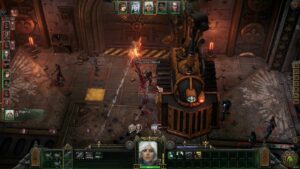I never imagined that Guilty Gear’s iconic pre-battle bark, “Heaven or hell? Duel one! Let’s rock!” would show up anywhere but in a video game. But now I’ve found myself saying it out loud whenever I start a match of Guilty Gear Strive: The Board Game. Adapting video games to the tabletop isn’t new, but the way it’s done here translates the fighting game into something I never thought possible.
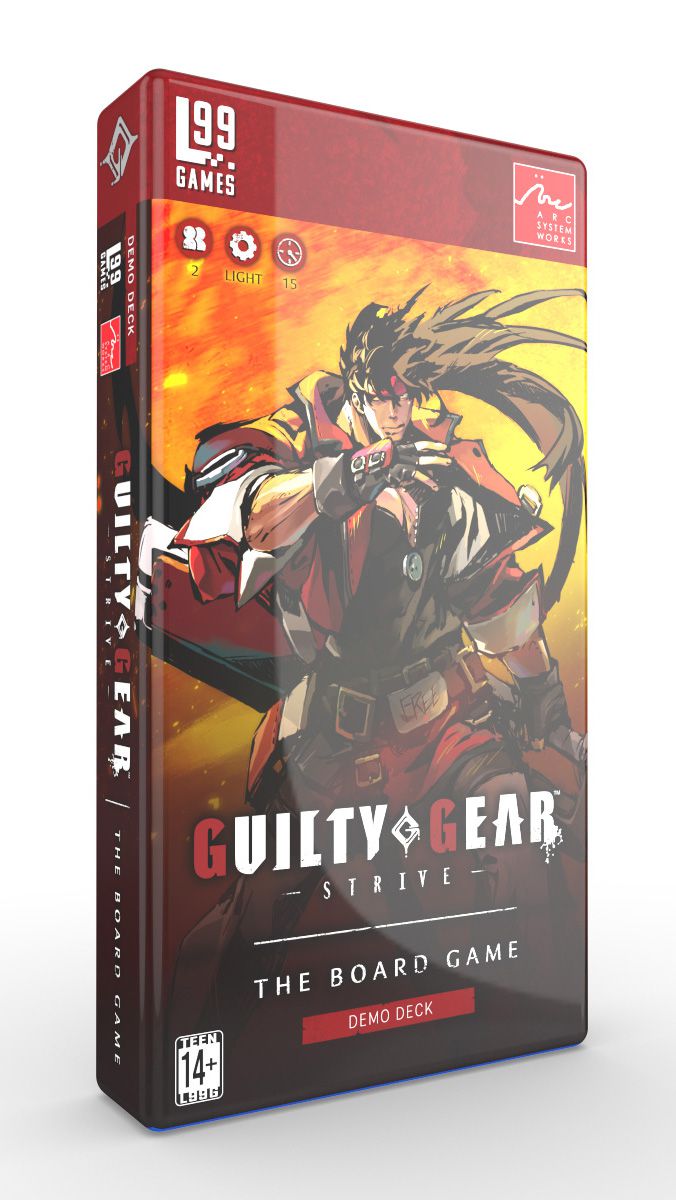
Developer Level 99 gave Polygon an exclusive sneak peek at the in-development game using a special demo deck, featuring fighters Sol Badguy and Ky Kiske. That same deck is available for free, while supplies last, on Level 99’s website. It even comes with a commemorative coin engraved with “heaven” on one side, “hell” on the other. The set will also be available for attendees at this year’s Evo 2023.
This new expression of the Guilty Gear franchise doesn’t just throw a bunch of familiar characters on a board and ask you to play Monopoly or whatever you’re thinking of. It quite literally breaks down how fighting games are played, expanding on the thought processes you have to use to play them well. The result is a surprisingly tactical tabletop experience.
The very concept of a board game adaptation seems daunting, especially with a highly technical fighting game series like Guilty Gear. You’ve got features like basic attacks, special attacks, counterattacks, special meters, EX attacks, frame data, blocking, movement, install transformations, and space control, just to name a few. Level 99’s design takes all of that and more, distilling it down into a slower-paced experience where each element is made to represent a separate game mechanic, directly mirroring its virtual sibling.
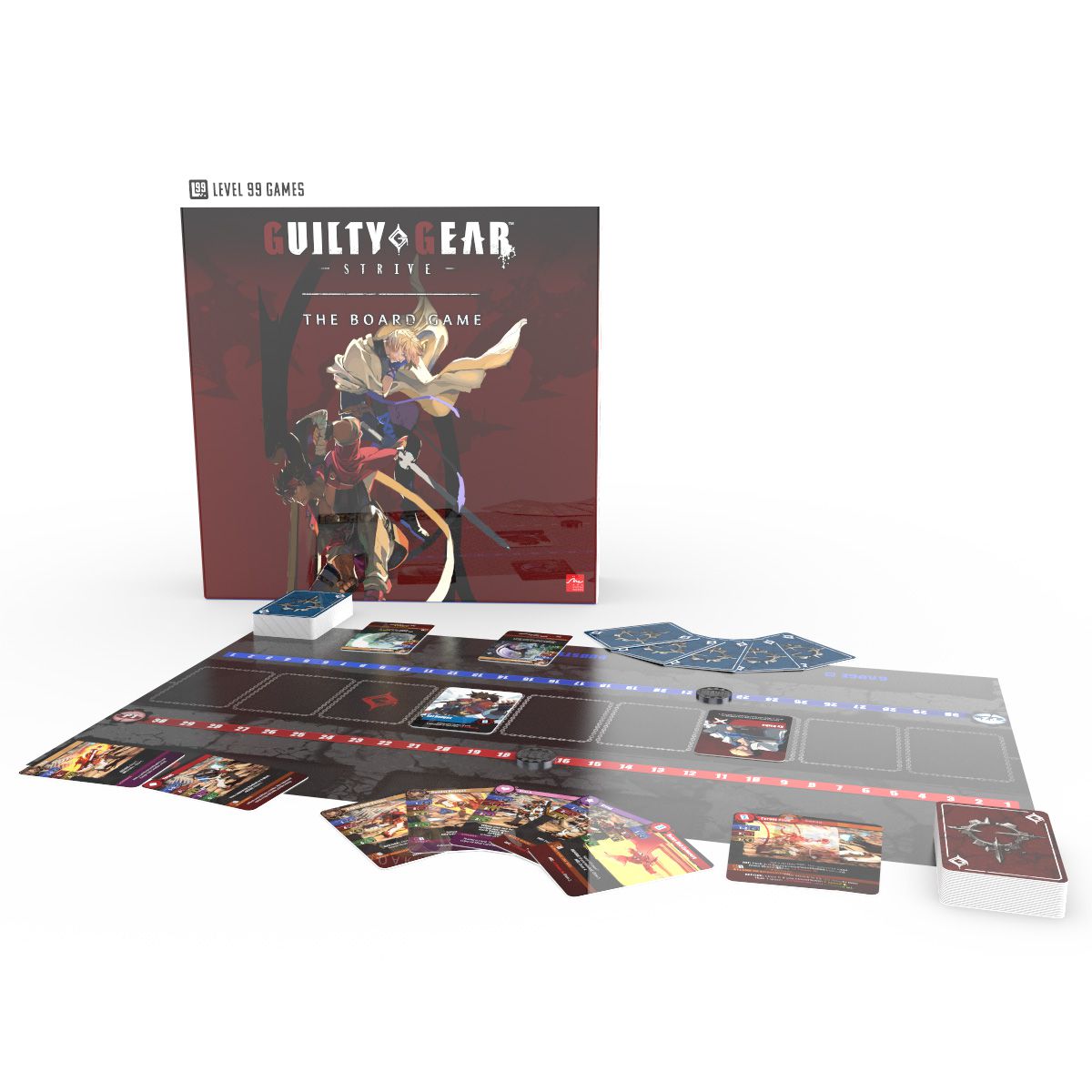
“There’s a lot of tactics in fighting games,” Level 99 president David Talton told Polygon in a recent interview. He’s tried his hand at plenty, but never felt comfortable enough to consider the competitive circuit. “I wondered if I could isolate those tactics from the execution required while still retaining that fast-paced, back-and-forth flow they’re known for, but lower-level players like me can’t seem to grasp.”
In a game of Guilty Gear Strive, two players sit head to head and fight with their characters using unique decks of cards. And, just as in a traditional fighting game experience, it takes a lot of outsmarting, prediction, and heavy decision making to win a best-of-three match.
To start, both players select their fighters. The final game will include a full roster of 20. Each character comes with a unique set of battle cards, an always-in-play ability, and its own install transformation — a secondary physical form that amplifies a character’s strengths or gives them access to an all-new ability. All of these moves are directly inspired by the actual Guilty Gear fighting games, including Ky Kiske’s electric projectile, Stun Edge, which has a range of two board spaces and gives the player frame advantage. The win condition is the same as it is in the virtual world: Hit your opponent enough to decrease their life bar down from 20 to zero. And, like in the very fighting game this tabletop title is based on, you can be as brutish or tactful as your heart desires.
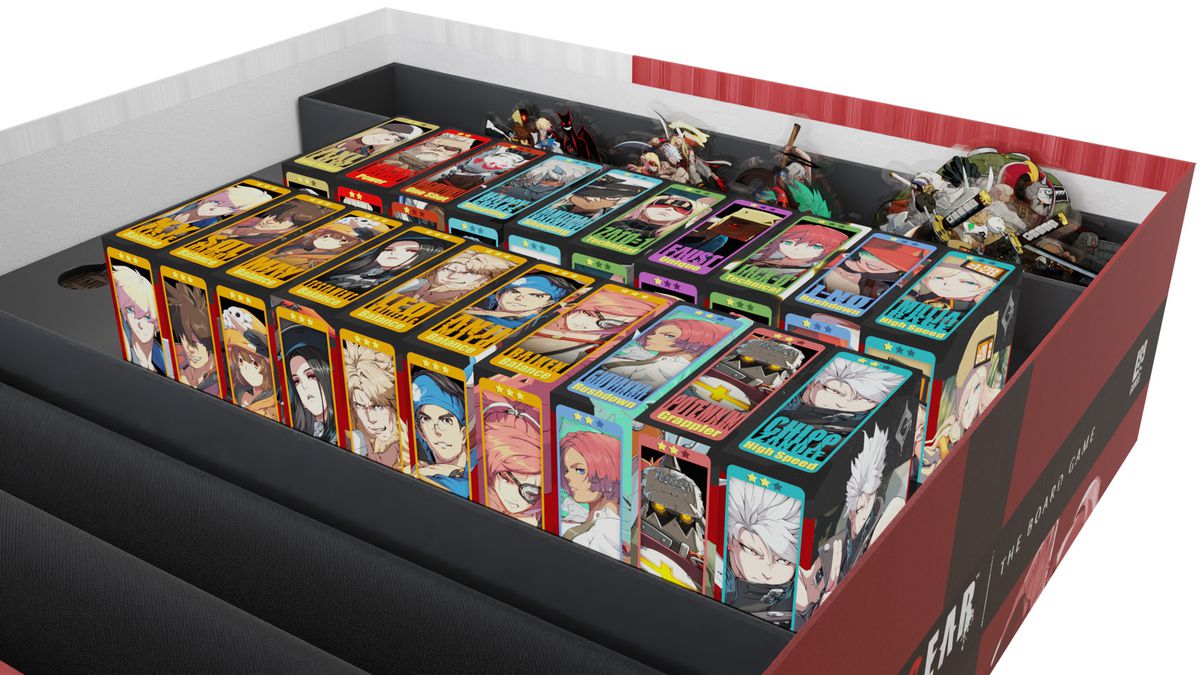
The game board itself is composed of a nine-space linear battlefield, with each character starting at the third space of either end of the board. To move toward, away from, or over your opponent, you must use a resource called Force, which is generated by discarding cards from your hand. Cards have multiple uses besides generating Force, including executing attacks. As in a traditional fighting video game, you’ll need to manage your range and resources to pull off certain actions and attacks. That makes managing your pool of Force all the more important.
Speaking of attack cards, there are a lot of them for each character, and every one has a very unique effect. Some cards allow you to move toward an enemy without needing to spend Force, while others push or pull the enemy away from you. And along with those standard abilities, there are Ultra Attacks and secondary effects on most attack cards called Boost. Both these alternate attack types give access to special skills that can pack a punch or make a character even stronger than before. Once a player uses one of these cards to strike they must take note of its power, range, speed, and guard. When it’s used, like in a typical fighter, the opponent can take a guess or predict and counter with a card of their own. Both players put their cards face down and reveal them to one another. Whichever attack has higher speed goes first, and if the power is higher than their opponent’s guard, the opponent is stunned and can’t counterattack. Similarly, if they’re pushed out of range and their attack range is too low, then they simply can’t reach for the attack. It’s a brilliant adaptation of the moment-by-moment action in the classic Guilty Gear style.
If you’re a fighting game fan and this all sounds familiar, that’s because it is. The stun is similar to frame advantage in fighting games, being pushed out of range and having to restart the neutral movement game. These are all concepts that are translated from fighting games to the tabletop amazingly well. I was able to apply my years of experience playing video games directly to the tabletop, coming up with many tactics that led to possible advantageous situations over my opponent.
For example, I’d constantly get my opponent in the corner and try to keep them there so they can waste extra Force resources in order to jump over me and escape. It’s even possible to shimmy and mix up opponents here by spending Force to retreat from a cornered opponent, bait a counterattack, and use a ranged attack to possibly stun them and get free damage. What’s hilarious about these transactions is that, just like in a typical fighting game, you can sort of mash for dear life if you don’t have the resources currently by Wild Swinging, which entails topdecking a random counter card during the attack sequence. I cracked up whenever that worked for me and my opponent would say, “Nice mash.”
Of course, the name of the game here is Guilty Gear, and aside from mechanics, there are a lot of little smells of the game here and there that prove that the license wasn’t wasted. Ky is this all-rounder with cards to fit every situation; Leo has his forward and back stance modes (each featuring separate move lists); Zato has an extra character piece in the form of Eddie, giving him two board spaces to attack from. There are just so many big nods to the series that show fans this isn’t just some slapped-together project. Especially when the coins used for the life bar come decorated with the iconic “heaven” and “hell” on both sides. And yes, you can use resources to cancel moves into other moves and basically combo an opponent’s classic Gear style.
Perhaps the best part is that Guilty Gear Strive: The Board Game will be fully compatible with other Level 99 Exceed fighting games — including BlazBlue, Under Night, Street Fighter, and even Shovel Knight. Finally we can all experience Guilty Gear vs. Street Fighter — albeit in a slightly different gaming genre.
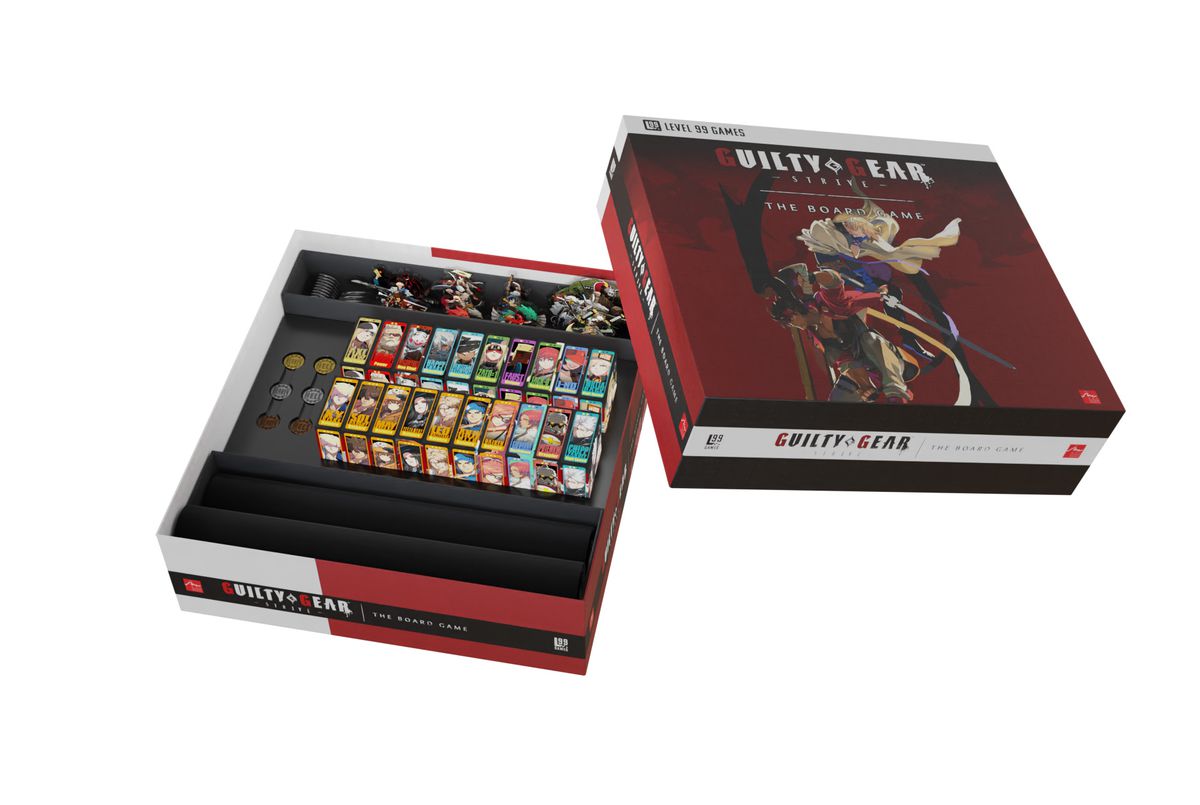
Level 99 will launch a Kickstarter campaign beginning on Aug. 22 and running through Sept. 14 that will allow fans to pre-order the base game at a discounted price. Once it reaches retail, Level 99 expects the game to cost $99. The final product will include 20 characters to play, a total of 695 cards, two neoprene playmats, and beautiful engraved metal coins — just like the ones being given away today. And if that’s not enough, then the $179 collector’s edition, sporting beautiful acrylic standees for each character, may satiate the Gear in you.
Guilty Gear Strive: The Board Game is clearly a labor of love. This experience is perfect for Guilty Gear fans looking for a new way to experience the formula or a simple collectible to show their love for the series. Fans that might not fit into the twitch-reaction world of fighting games but thrive in the board game realm will love it. But anyone that loves fighters and the vibe they put into the word can appreciate what Level 99 has done here.
- SEO Powered Content & PR Distribution. Get Amplified Today.
- PlatoData.Network Vertical Generative Ai. Empower Yourself. Access Here.
- PlatoAiStream. Web3 Intelligence. Knowledge Amplified. Access Here.
- PlatoESG. Automotive / EVs, Carbon, CleanTech, Energy, Environment, Solar, Waste Management. Access Here.
- BlockOffsets. Modernizing Environmental Offset Ownership. Access Here.
- Source: https://www.polygon.com/23817149/guilty-gear-board-game-kickstarter-free-demo-copy-release-date-price
- :has
- :is
- :not
- :where
- $UP
- 14
- 20
- 2023
- 22
- a
- abilities
- ability
- Able
- About
- access
- Action
- actions
- actual
- adaptation
- ADvantage
- advantageous
- All
- allow
- along
- also
- an
- and
- Another
- anyone
- anywhere
- Apply
- appreciate
- ARE
- AS
- At
- attack
- Attacks
- attendees
- Aug
- available
- away
- back
- bait
- bar
- base
- based
- basic
- Basically
- Battle
- Battlefield
- BE
- beautiful
- because
- before
- Beginning
- being
- besides
- BEST
- Big
- blocking
- board
- boost
- both
- Both Sides
- Box
- boxes
- breaks
- brilliant
- Bunch
- but
- by
- called
- Campaign
- CAN
- card
- Cards
- case
- certain
- character
- characters
- classic
- clearly
- Coin
- Coins
- Collectible
- come
- comes
- comfortable
- coming
- commemorative
- compatible
- competitive
- composed
- concept
- concepts
- condition
- Consider
- constantly
- control
- Corner
- cornered
- Cost
- could
- Counter
- course
- cracked
- Currently
- damage
- data
- David
- decision
- Decision Making
- decrease
- Demo
- Design
- different
- directly
- Doesn’t
- done
- Dont
- down
- DUEL
- during
- each
- Edge
- edition
- effect
- effects
- either
- Electric
- element
- end
- enough
- escape
- especially
- Ether (ETH)
- Even
- Every
- example
- exceed
- Exclusive
- executing
- execution
- expanding
- expects
- experience
- expression
- extra
- Face
- familiar
- fan
- fans
- fast-paced
- Features
- Featuring
- few
- fight
- fighters
- fighting
- Fighting game
- final
- Finally
- First
- fit
- flow
- For
- Force
- form
- formula
- Forward
- found
- FRAME
- Franchise
- Free
- from
- full
- fully
- game
- game series
- Games
- gaming
- Gear
- generated
- generating
- get
- Give
- given
- gives
- Giving
- Goes
- grasp
- Guard
- guilty
- hand
- Have
- having
- head
- Heart
- heavy
- here
- higher
- highly
- hilarious
- him
- his
- Hit
- How
- http
- HTTPS
- i
- iconic
- if
- imagined
- important
- in
- include
- Including
- inspired
- install
- interior
- Interview
- into
- IT
- ITS
- itself
- jpg
- jump
- just
- Keep
- kickstarter
- known
- labor
- Last
- launch
- Led
- LEO
- Level
- License
- Life
- like
- Lists
- little
- looking
- LOOKS
- Lot
- love
- loves
- Low
- made
- make
- MAKES
- Making
- manage
- managing
- many
- Match
- May..
- me
- mechanics
- metal
- might
- mirroring
- mix
- modes
- more
- most
- move
- movement
- moves
- multiple
- must
- my
- name
- Need
- needing
- Neutral
- never
- New
- Nintendo
- Nintendo Switch
- now
- of
- off
- on
- once
- ONE
- ones
- opponents
- or
- order
- Other
- Others
- out
- over
- own
- Pack
- part
- perfect
- physical
- piece
- plastic
- plato
- Plato Data Intelligence
- PlatoData
- Play
- played
- player
- players
- playing
- Plenty
- Polygon
- pool
- possible
- possibly
- power
- pre-order
- predict
- prediction
- president
- price
- processes
- Product
- project
- Prove
- punch
- Push
- pushed
- put
- random
- range
- reach
- Reaches
- realm
- recent
- represent
- required
- resource
- Resources
- result
- retail
- retaining
- Retreat
- reveal
- roster
- running
- same
- say
- saying
- secondary
- seem
- seems
- separate
- Sequence
- Series
- set
- several
- show
- showing
- side
- Sides
- similar
- Similarly
- Simple
- simply
- sit
- situation
- situations
- skills
- slightly different
- sneak
- So
- SOL
- some
- something
- Space
- spaces
- special
- speed
- spend
- Spending
- standard
- start
- Starting
- Still
- street
- strengths
- strike
- strive
- stronger
- style
- Switch
- tactical
- tactics
- Take
- takes
- Technical
- than
- that
- The
- The Coins
- their
- Them
- then
- There.
- These
- they
- Thinking
- Third
- this
- those
- thought
- Thrive
- Through
- Title
- to
- today
- too
- Total
- toward
- traditional
- Transactions
- Transformation
- transformations
- tried
- try
- two
- types
- typical
- Ultra
- unique
- use
- used
- uses
- using
- very
- Vibe
- Video
- video game
- video games
- Virtual
- virtual world
- vs
- was
- Waste
- Way..
- we
- webp
- WELL
- What
- whatever
- when
- whenever
- which
- while
- Wild
- will
- win
- with
- without
- Word
- worked
- world
- would
- years
- yes
- you
- Your
- zephyrnet
- zero





